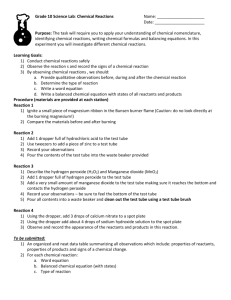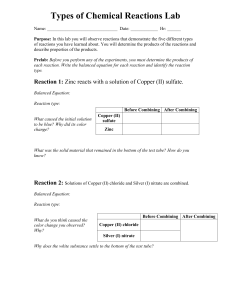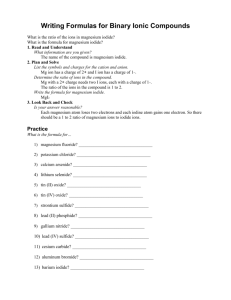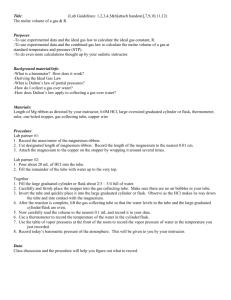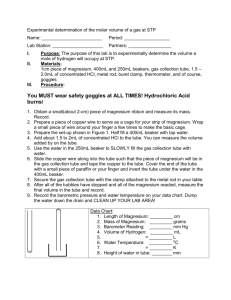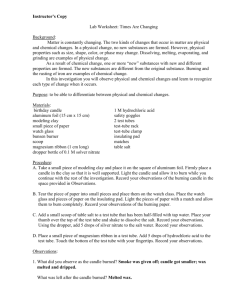Types of Chemical Reactions
advertisement
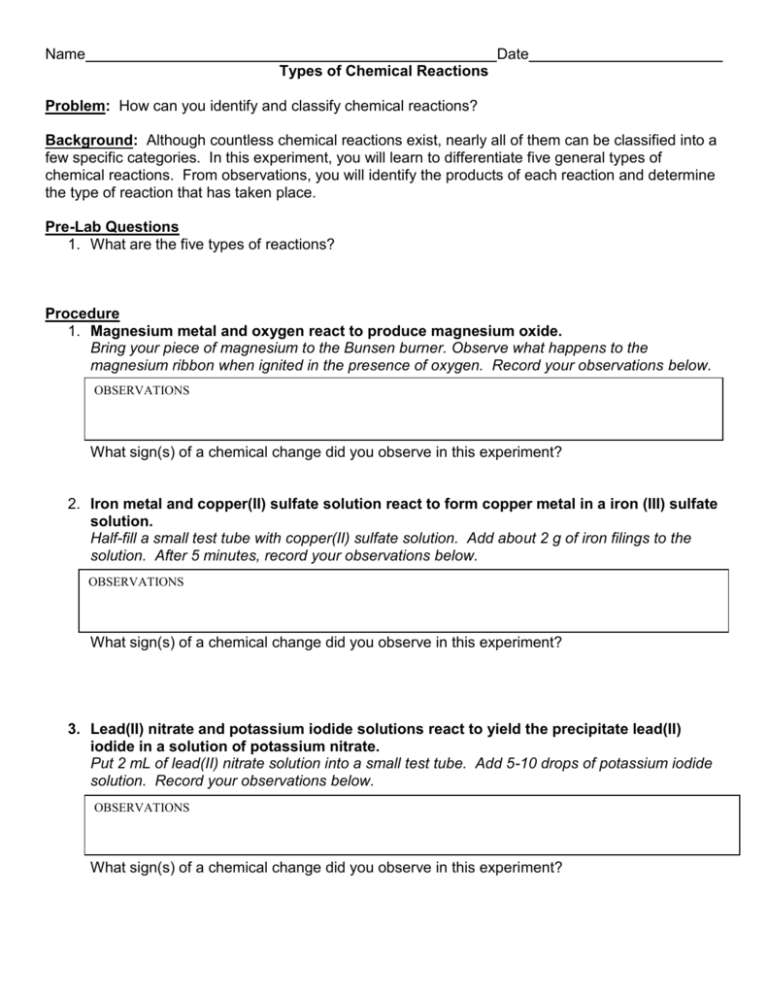
Name Date Types of Chemical Reactions Problem: How can you identify and classify chemical reactions? Background: Although countless chemical reactions exist, nearly all of them can be classified into a few specific categories. In this experiment, you will learn to differentiate five general types of chemical reactions. From observations, you will identify the products of each reaction and determine the type of reaction that has taken place. Pre-Lab Questions 1. What are the five types of reactions? Procedure 1. Magnesium metal and oxygen react to produce magnesium oxide. Bring your piece of magnesium to the Bunsen burner. Observe what happens to the magnesium ribbon when ignited in the presence of oxygen. Record your observations below. OBSERVATIONS What sign(s) of a chemical change did you observe in this experiment? 2. Iron metal and copper(II) sulfate solution react to form copper metal in a iron (III) sulfate solution. Half-fill a small test tube with copper(II) sulfate solution. Add about 2 g of iron filings to the solution. After 5 minutes, record your observations below. OBSERVATIONS What sign(s) of a chemical change did you observe in this experiment? 3. Lead(II) nitrate and potassium iodide solutions react to yield the precipitate lead(II) iodide in a solution of potassium nitrate. Put 2 mL of lead(II) nitrate solution into a small test tube. Add 5-10 drops of potassium iodide solution. Record your observations below. OBSERVATIONS What sign(s) of a chemical change did you observe in this experiment? 4. When magnesium metal is placed in hydrochloric acid, hydrogen gas and aqueous magnesium chloride are formed. Half-fill a medium-sized test tube with 6M hydrochloric acid. Place the test tube in a test tube rack and add several magnesium turnings. Identify any gas that forms by using crucible tongs to hold a burning wood splint at the mouth of the test tube. Record your observations below. OBSERVATIONS What sign(s) of a chemical change did you observe in this experiment? 5. When exposed to light or heat, hydrogen peroxide will decompose to form water and oxygen gas. Add 2 mL of 3% hydrogen peroxide solution to the 10-mL graduated cylinder. Pour a thin layer of soap on top of the hydrogen peroxide solution. Because this reaction is so slow, add MnO 2, which will serve as a catalyst and speed up the reaction. Record your observations below. OBSERVATIONS What sign(s) of a chemical change did you observe in this experiment? Analysis 1. For each reaction, write a “word equation” and then write a balanced chemical reaction for each of the five reactions performed. Reaction 1: Word Equation magnesium + oxygen magnesium oxide Balanced Chemical Equation Reaction 2: Word Equation Balanced Chemical Equation Reaction 3: Word Equation Balanced Chemical Equation Reaction 4: Word Equation Balanced Chemical Equation Reaction 5: Word Equation Balanced Chemical Equation 2. Classify each of the observed reactions as one of the five reaction types. Reaction Type of Reaction 1 2 3 4 5 3. Although no hydrocarbon combustion reactions were described in the Procedure section, a combustion reaction did occur in the course of this experiment. The reactant is CH4 (natural gas). Write a balanced equation for the combustion of this substances. CH4 + Conclusion Describe in your own words the five types of chemical reactions listed in the Background section. Explain how to distinguish each of these types of reactions.


